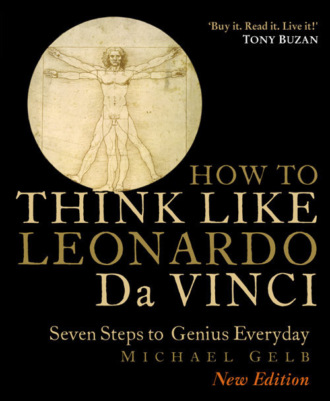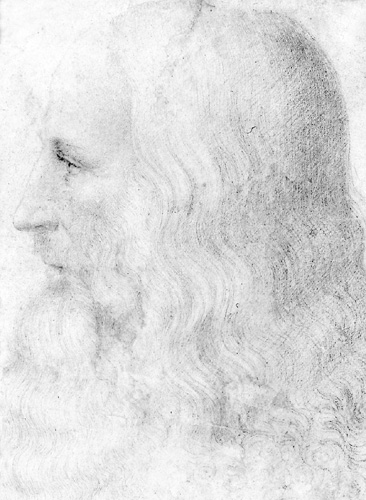
Полная версия
Think Like Da Vinci: 7 Easy Steps to Boosting Your Everyday Genius
10. Albert Einstein
9. Phidias (architect of Athens)
8. Alexander the Great
7. Thomas Jefferson
6. Sir Isaac Newton
5. Michelangelo
4. Johann Wolfgang von Goethe
3. The Great Pyramid Builders
2. William Shakespeare
And the greatest genius of all time, according to Buzan and Keene’s exhaustive research? Leonardo da Vinci.
As Giorgio Vasari wrote of Leonardo in the original version of his The Lives of the Artists, “Heaven sometimes sends us beings who represent not humanity alone but divinity itself, so that taking them as our models and imitating them, our minds and the best of our intelligence may approach the highest celestial spheres. Experience shows that those who are led to study and follow the traces of these marvelous geniuses, even if nature gives them little or no help, may at least approach the supernatural works that participate in his divinity.”
Our evolving understanding of the multiplicity of intelligence and the capacities of the brain suggests that nature gives us more help than we might have imagined. In Think Like Da Vinci we will “study and follow the traces” of this most marvelous of all geniuses, bringing his wisdom and inspiration to your life, every day.
A PRACTICAL APPROACH TO GENIUS
In the pages that follow you will learn a practical approach, tested in experience, for applying the essential elements of Leonardo’s genius to enrich your life. You will discover an exhilarating, original way of seeing and enjoying your world as you develop powerful strategies for creative thinking and new approaches to self-expression. You’ll learn proven techniques for sharpening your senses, liberating your unique intelligence, and harmonizing body and mind. With Leonardo as your inspiration, you will make your life a work of art.
Although you may already be familiar with Da Vinci’s life and work, you’ll finish this book with a fresh perspective and a deeper appreciation for this most enigmatic figure. Looking at the world from his point of view, you may also get a taste of the loneliness genius brings. But I guarantee that you’ll be uplifted by his spirit, inspired by his quest, and exalted by your association with him.
The book begins with a capsule review of the Renaissance and its parallels with our time, followed by a biographical sketch of Leonardo and a summary of his major accomplishments. The heart of the book is the discussion of the Seven Da Vincian Principles. These principles are drawn from an intensive study of the man and his methods. I’ve named them in Leonardo’s native Italian. The good news is that Leonardo’s principles will probably be intuitively obvious to you. You do not have to try to invent them in your life. Rather, like much of common sense, they need to be remembered, developed, and applied.
Giorgio Vasari (1511–1574), architect of Florence’s Uffizi and a pupil of Michelangelo’s, originally published his The Lives of the Artists in 1549. He was credited by scholars with effectively inventing the discipline of art history with that book. Lives remains the most important source on Italian Renaissance art. With uncanny flair Vasari profiles the lives and work of almost two hundred painters, sculptors, and architects, including Giotto, Masaccio, Brunelleschi, Donatello, Botticelli, Verrocchio, Raphael, Michelangelo, Titian, and, of course, Leonardo.
The Seven Da Vincian Principles are:
Curiosità – An insatiably curious approach to life and an unrelenting quest for continuous learning.
Dimostrazione – A commitment to test knowledge through experience, persistence, and a willingness to learn from mistakes.
Sensazione – The continual refinement of the senses, especially sight, as the means to enliven experience.
Sfumato (literally “Going up in Smoke”) – A willingness to embrace ambiguity, paradox, and uncertainty.
Arte/Scienza – The development of the balance between science and art, logic and imagination. “Whole-brain” thinking.
Corporalita – The cultivation of grace, ambidexterity, fitness, and poise.
Connessione – A recognition of and appreciation for the interconnectedness of all things and phenomena. Systems thinking.
Having read this far, you are already applying the first Da Vincian principle. Curiosità – the quest for continuous learning – comes first because the desire to know, to learn, and to grow is the powerhouse of knowledge, wisdom, and discovery.
If you are interested in thinking for yourself and freeing your mind from limiting habits and preconceptions, then you are on track for the second principle: Dimostrazione. In his search for truth, Da Vinci insisted on questioning conventional wisdom. He used the word dimostrazione to express the importance of learning for oneself, through practical experience.
Pause for a few moments, and recall the times in the past year when you felt most vividly alive. Chances are, your senses were heightened. Our third principle – Sensazione – focuses on sharpening the senses, consciously. Leonardo believed that refining sensory awareness was the key to enriching experience.

Portrait of the Maestro.
As you sharpen your senses, probe the depths of experience, and awaken your childlike powers of questioning, you will encounter increasing uncertainty and ambiguity. “Confusion endurance” is the most distinctive trait of highly creative people, and Leonardo probably possessed more of that trait than anyone who has ever lived. Principle number four – Sfumato – guides you to be more at home with the unknown, to make friends with paradox.
For balance and creativity to emerge from uncertainty requires principle number five – Arte/Scienza – or what we now call whole-brain thinking. But Da Vinci believed that balance was more than just mental. He exemplified and affirmed the importance of principle number six – Corporalita – the balance of body and mind. And if you appreciate patterns, relationships, connections, and systems – if you seek to understand how your dreams, goals, values, and highest aspirations can be integrated into your daily life – then you are already applying principle number seven: Connessione. Connessione ties everything together.
“We respect him by learning from him.”
– FREUD ON DA VINCI
Each principle is highlighted by excerpts from the maestro’s notebooks and illustrated with his sketches or paintings. This illumination is followed by some questions for reflection and self-assessment. These questions are designed to stimulate your thinking and inspire your application of the principles. The questions are followed by a program of practical exercises for cultivating a personal and professional Renaissance. To get the most benefit from Think Like Da Vinci, read the whole book first, without doing the exercises. Just contemplate the questions for reflection and self-assessment. After this preview, review the explanation of each principle and then do the exercises. Some of the exercises are easy and fun, while others require challenging inner work. All are designed to bring the spirit of the maestro to your daily life. In addition to the exercises, you will find an annotated reading and resource list to guide you in exploring and applying each principle. The reading list includes recommendations on the Renaissance, the history of ideas, the nature of genius, and, of course, the life and work of Leonardo.
In the final section of the book you will discover “The Beginner’s Da Vinci Drawing Course,” and you’ll also learn how you can participate in a history-making project that embodies the essence of the Da Vincian spirit.
Конец ознакомительного фрагмента.
Текст предоставлен ООО «ЛитРес».
Прочитайте эту книгу целиком, купив полную легальную версию на ЛитРес.
Безопасно оплатить книгу можно банковской картой Visa, MasterCard, Maestro, со счета мобильного телефона, с платежного терминала, в салоне МТС или Связной, через PayPal, WebMoney, Яндекс.Деньги, QIWI Кошелек, бонусными картами или другим удобным Вам способом.




